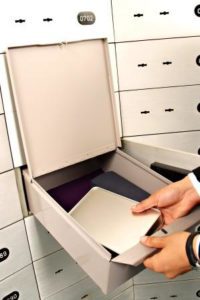 When floods, fires and other disasters strike, you may have little or no time to protect your valuables, but you can safeguard your treasured belongings from damage or loss by taking a few simple steps today. According to Long & Foster Insurance, a leading independent insurance agency that represents many of the nation’s top rated insurance companies, you’ll first need to take an inventory of your valuables. You’ll want to identify what you have by going through your home and then documenting each item. The below checklist will help you in the process.
When floods, fires and other disasters strike, you may have little or no time to protect your valuables, but you can safeguard your treasured belongings from damage or loss by taking a few simple steps today. According to Long & Foster Insurance, a leading independent insurance agency that represents many of the nation’s top rated insurance companies, you’ll first need to take an inventory of your valuables. You’ll want to identify what you have by going through your home and then documenting each item. The below checklist will help you in the process.
-
Vital records and certificates (birth, marriage, divorce, adoption, child custody, death)
-
Passport, driver’s license, Social Security card and other identification documents
-
Property leases, deeds, mortgages, titles (auto, home) and other legal records
-
Financial records, including recent tax returns, copies of pay stubs and bank account statements, and debit and credit card numbers
-
Insurance policies
-
Wills, living wills and powers of attorney
-
Medical records, including prescription medicines, medical conditions, medical provider contact information and copies of health insurance/Medicare/Medicaid cards
-
Safe deposit box information and keys
-
Records of passwords and personal identification numbers (PINs)
-
Family photos, keepsakes, jewelry or other mementos
-
Photographic or data inventory of valuables (photos, videos, CD/flash drive)
-
Other items
Once you complete your checklist, there are a number of simple no-cost or low-cost steps you can take to protect your valuables:
-
Create a photographic record or inventory of your valuables and store it in a safe deposit box or other off-site location. Consider keeping a copy on a CD or flash drive in your disaster kit, so that you can provide it to your insurance company following a loss; this will allow you to start the insurance/recovery process more quickly.
-
Scan important documents, such as medical records and financial documents, and save the files. You may want to password-protect the data you have stored in case of loss or theft. Store the backup records in a safe deposit box or other off-site location.
-
If you have too many records or no way to scan/copy them, store them in a flood/fireproof home safe or a safe deposit box. Also, consider having your family members store backup copies of important documentation for you.
-
If you have valuable items stored in a basement, move them to a higher location to avoid water damage.
-
Include any readily accessible records, such as medical records and medical contact information, in your disaster kit.
-
In some cases, you may be able to protect valuables in waterproof containers available in sporting goods or hardware stores. For smaller items, a flood/fireproof home safe may provide temporary protection.
-
Take precautions to protect yourself from identity theft when you create backup systems to store critical information.
Having a home inventory on hand helps speed along the process. Not sure how to create one? You can create a digital home inventory by downloading our Excel spreadsheet here. You can also make a handwritten home inventory by downloading and printing off a PDF version here.
In addition to insuring your home, Long & Foster Insurance is committed to helping you and your loved ones stay safe when disaster strikes. If you would like more information on developing a family emergency plan or building a disaster supply kit, please contact Long & Foster Insurance at 1-866-275-4534 or www.longandfosterinsurance.com today.